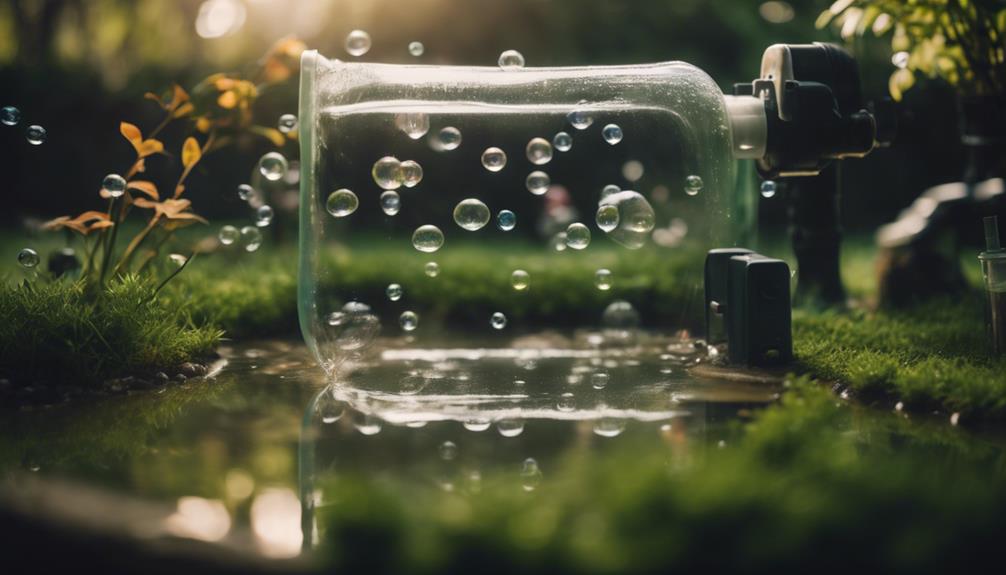You're about to reveal the secrets to a thriving fish pond ecosystem by mastering DIY fish pond aeration hacks. First, design a cost-effective aeration system considering pond depth and volume to determine the required pump size and air line length. Then, assemble essential components, including weighted air lines, air stones, and weatherproof pump housing. Boost oxygen levels and water quality by implementing sub-surface diffused aeration, fine bubble diffusion, and solar-powered systems. Next, customize air pumps and accessories, and master woodworking essentials for aeration system building. By applying these hacks, you'll be well on your way to creating a balanced aquatic habitat – and there's still more to explore.
Table of Contents
Key Takeaways
- Select the right air pump size and air line length to ensure efficient oxygenation and prevent overspending on oversized pumps.
- Use weighted air lines to prevent floating on the surface and ensure durability, with thick-walled lines providing better lifespan than standard lines.
- Place diffusers near the pond floor, at a 45-60 degree angle, to achieve ideal oxygen distribution and circulation within the pond.
- Regularly clean and maintain diffusers, air pumps, and accessories to ensure peak system performance and prevent corrosion.
- Consider solar-powered pond aeration systems for a low-cost, energy-efficient solution that harnesses renewable energy and reduces carbon footprint.
Cost-Effective Aeration System Design
When designing a cost-effective aeration system for your DIY fish pond, you'll want to carefully consider the pond's depth and volume to determine the required pump size and air line length, as this will greatly impact the system's overall performance and efficiency.
For instance, linear compressors are suitable for depths up to 8 feet, while rocking piston compressors can handle depths from 6 to 50 feet. This guarantees you don't overspend on an oversized air pump, which can be a significant cost factor.
Additionally, the air line length and material play a vital role in the system's effectiveness. You'll want to use a weighted air line to prevent it from floating on the surface, and opt for a thick-walled weighted line for its durability and longer lifespan.
Essential Components and Assembly Tips
Now that you've determined the required pump size and air line length for your DIY fish pond, it's time to gather the necessary components to bring your aeration system to life. Make sure you have all the essential parts, including the air pump, soft oxygen air hose, air stone, weatherproof pump and electrical housing/enclosure, and red and black wires.
| Component | Importance |
|---|---|
| Air Pump | Provides oxygen to the pond |
| Soft Oxygen Air Hose | Transfers oxygen from pump to air stone |
| Air Stone | Releases oxygen into the water |
First thing, design a plan on paper to visualize the assembly process and guarantee a smooth setup. When preparing and assembling the parts, attention to detail and basic DIY skills are necessary. You'll need to solder wires, prepare wires, use heat shrink tubing, and attach wires to pump terminals. Take your time and go back to double-check your work to avoid mistakes.
Boosting Oxygen Levels and Water Quality
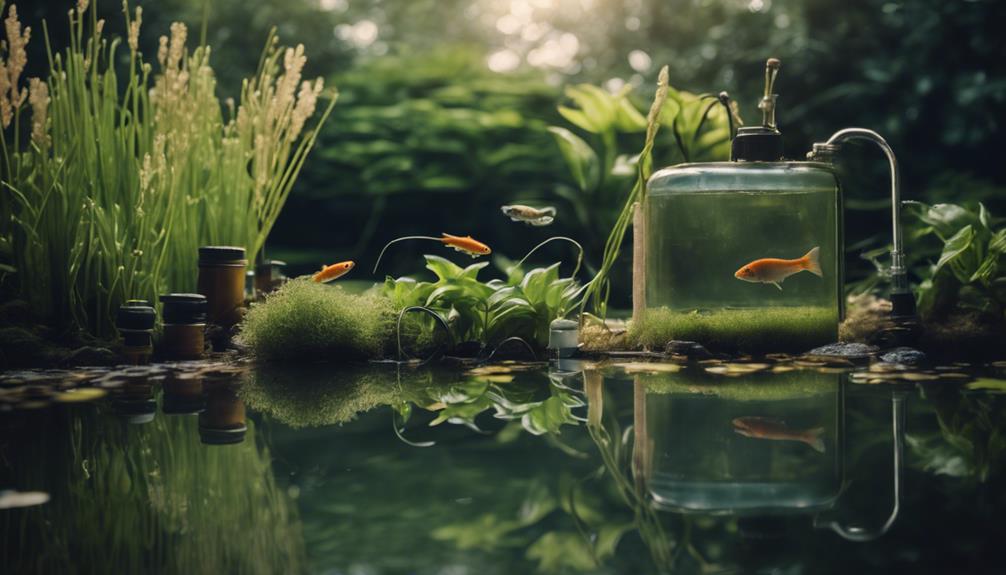
As you set out to boost oxygen levels and improve water quality in your DIY fish pond, you'll want to focus on the most effective aeration methods and air diffusion techniques.
By choosing the right approach, you can distribute oxygen more evenly throughout the pond, reducing algae growth and sedimentation.
Let's take a closer look at the techniques that'll help you achieve ideal oxygen levels and a healthier environment for your aquatic friends.
Aeration Methods
You can substantially boost oxygen levels and improve water quality in your DIY fish pond by employing a combination of aeration methods that work synergistically to introduce oxygen into the water.
One effective approach is sub-surface diffused aeration, which can be achieved through DIY systems using linear compressors and weighted air lines. This method isn't only economical but also efficient in distributing oxygen far away from the aerator, guaranteeing that every corner of your pond receives the necessary oxygen.
Fine bubble diffusion is a preferred method for DIY pond aeration systems as it provides better oxygenation and more balanced mixing than coarse bubble diffusion. By using fine bubble diffusers, you can increase oxygen levels three times more effectively than with coarse bubble diffusers.
Air Diffusion Techniques
When it comes to boosting oxygen levels and water quality in your DIY fish pond, mastering air diffusion techniques is key, and fine bubble diffusion stands out as a superior method due to its exceptional oxygenation capabilities and balanced mixing. Fine bubble diffusion provides much better oxygenation and more balanced mixing than coarse bubble diffusion, making it a preferred method for pond aeration.
Here's a comparison of the three types of diffusers:
| Diffuser Type | Description | Effectiveness |
|---|---|---|
| Fine Rubber Membrane | Small holes for efficient air diffusion | High |
| Oval-Shaped with Fine Pinholes | Releases bubbles from the top for effective oxygenation | High |
| Easy Pro's Membrane Plate | Numerous small holes for improved oxygenation | High |
Stay away from coarse bubble diffusion, as it can lead to poor oxygenation and water quality. By using fine bubble diffusion, you'll require less air input for better results, making it a cost-effective solution for improving pond water quality and oxygen levels. With the right diffuser, you'll be able to create a thriving environment for your fish to flourish.
Solar-Powered Pond Aeration Benefits
When you opt for a solar-powered pond aeration system, you'll reap the benefits of a low-cost energy source, increased oxygen levels, and an environmentally friendly option.
By harnessing the sun's energy, you'll reduce your reliance on traditional power sources and create a healthier habitat for your aquatic life.
As you explore the advantages of solar-powered pond aeration, you'll discover how it can transform your pond's ecosystem while saving you money and minimizing your carbon footprint.
Low-Cost Energy Source
By tapping into the abundant energy of the sun, solar-powered pond aeration systems offer a low-cost and environmentally friendly alternative to traditional electric-powered aeration methods.
As you consider switching to a solar-powered system, you'll appreciate the numerous benefits it provides.
You'll enjoy energy independence, reducing your reliance on the grid and lowering your electricity bills.
With a solar-powered system, you're embracing green living, minimizing your carbon footprint and contributing to a more sustainable future.
By harnessing renewable energy, you'll be taking advantage of a free and limitless resource, substantially reducing your operating costs.
With a solar-powered pond aeration system, you can rest assured that you're not only saving money but also doing your part for the environment.
Plus, the initial investment can be markedly lower than traditional electric-powered systems, making it an attractive option for pond owners on a budget.
Increased Oxygen Levels
As you seek to create a thriving ecosystem in your pond, you'll find that increasing oxygen levels is a critical aspect of maintaining a healthy environment, and solar-powered pond aeration systems are an effective way to achieve this goal. By increasing oxygen levels, you'll create a more favorable fish habitat, where your aquatic friends can thrive.
Here are some key benefits of solar-powered pond aeration systems:
| Benefit | Description | Impact |
|---|---|---|
| Improved Water Circulation | Increases oxygen levels and reduces stagnation | Healthier fish habitats |
| Reduced Stress and Disease | Helps fish grow and survive | Stronger aquatic balance |
| Reduced Algae Growth | Improves water clarity and transparency | More balanced ecosystem |
| Cost-Effective | Harnesses renewable energy from the sun | Environmentally friendly |
Environmentally Friendly Option
You can substantially reduce your pond's carbon footprint and dependence on fossil fuels by opting for a solar-powered pond aeration system, which harnesses renewable energy from the sun to power its operation. This eco-friendly solution is perfect for those who prioritize sustainable living and want to minimize their impact on the environment.
By choosing a solar-powered pond aeration system, you'll not only reduce your reliance on fossil fuels but also enjoy several benefits, including:
Increased oxygen levels and improved water quality, which enhance aquatic life and reduce algae growth and sedimentation
Energy efficiency and cost-effectiveness, making it an ideal option for small to medium-sized ponds
Low maintenance requirements, with regular cleaning of the solar panel and air pump ensuring peak performance and longevity
As you consider DIY fish pond aeration hacks, remember that solar-powered pond aeration systems are a great way to adopt renewable energy and contribute to a more sustainable future. By harnessing the power of the sun, you'll be doing your part for the environment while also creating a thriving ecosystem for your fish to flourish.
DIY Air Pump and Accessory Hacks
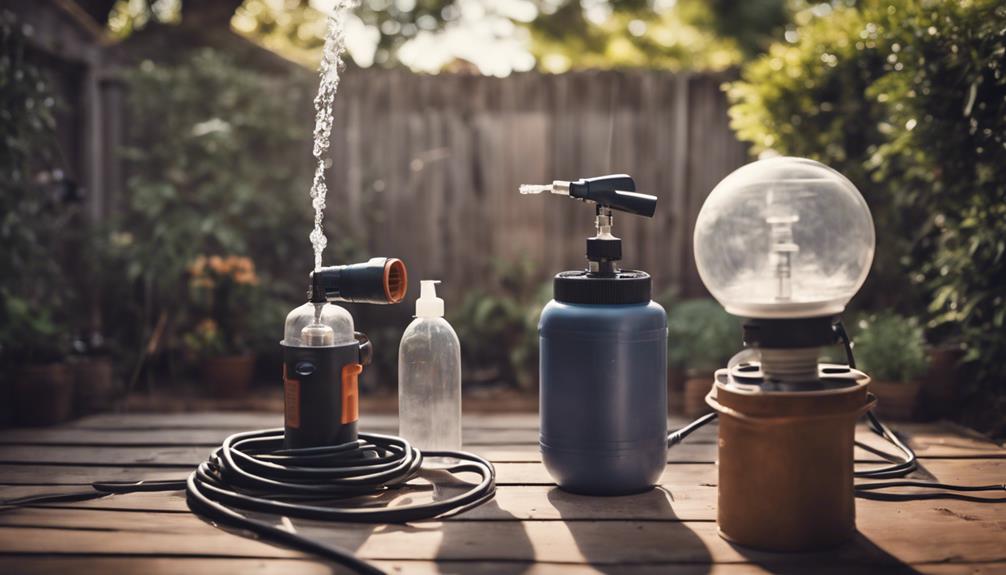
Customizing your air pump and accessories is essential to creating an efficient and tailored DIY pond aeration system that meets your specific pond's needs.
When it comes to pump customization, you can upgrade or replace components to maximize performance. For instance, you can modify the tubing to guarantee a snug fit and reduce air leaks. You can also use heat shrink tubing to protect the wires from water damage.
Speaking of wire management, you can solder the wires to prevent corrosion and guarantee a secure connection.
Additionally, you can customize the air stones and diffusers to enhance oxygen distribution. By upgrading these accessories, you can increase the system's efficiency and create a healthier environment for your fish.
Regular cleaning and maintenance of these components are also pivotal to guarantee peak system performance and prolong their lifespan.
Environmental Considerations for Optimal Performance
When designing a DIY fish pond aeration system, it's vital to ponder the environmental factors surrounding your pond, as they can markedly impact the system's performance and effectiveness.
You'll need to contemplate the pond's location and surroundings, including weather, temperature, and humidity, as well as vegetation, rocks, and wildlife that may interfere with system installation.
To guarantee peak performance, you should conduct pond mapping to identify areas with limited sunlight, which can affect solar-powered aeration systems.
Implement climate adaptation strategies to account for changing weather conditions and their impact on water flow.
Regularly monitor outdoor conditions, including water levels and flow rates, to adapt to changing environmental conditions.
Woodworking Essentials for Aeration System Building
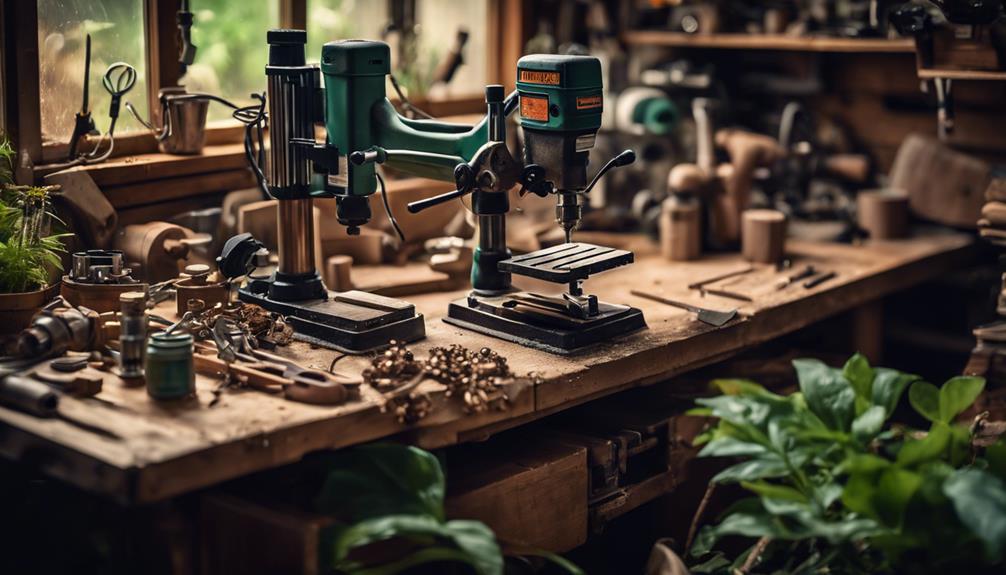
When building an aeration system for your DIY fish pond, you'll need to get familiar with woodworking essentials.
You'll want to master wood preparation techniques to guarantee your system's wooden components can withstand the outdoor elements and water exposure.
Wood Preparation Techniques
To guarantee the durability and longevity of your DIY aeration system, you'll need to prepare your wood materials properly, using techniques that prevent warping, cracking, and rotting. As a DIY enthusiast, you want to certify your system stands the test of time and harsh outdoor conditions.
When it comes to wood preparation, you'll need to focus on three key areas:
- Wood sealing techniques: Apply a waterproof sealant to protect your wood from moisture and decay. This is especially vital for outdoor components that'll be exposed to water and humidity.
- Wood grain considerations: Always work with the wood grain to prevent splitting and cracking. This means cutting and drilling in the direction of the grain, rather than against it.
- Wood moisture testing: Use a moisture meter to certify your wood is dry and ready for use. This is critical, as wood that's too moist can lead to warping, cracking, and rotting over time.
System Design Considerations
Now that you've prepared your wood materials, you'll need to apply your woodworking skills to design and build the components of your DIY aeration system, including the weatherproof pump and electrical housing/enclosure.
As you design your system, consider the system requirements, such as the size and shape of your pond, to guarantee your components fit perfectly.
This is where design flexibility comes in – you'll need to adapt your design to accommodate unique pond features.
Remember, structural integrity is vital, so focus on building sturdy components that can withstand outdoor elements.
When building your wooden enclosure, accurate measurements and precise cuts are essential for a secure and watertight fit.
Use techniques like drilling, cutting, and sanding to create custom-fit components that protect your pump and electrical components from rain, snow, and extreme temperatures.
Material Selection Criteria
You'll need to carefully evaluate the material selection criteria for your DIY aeration system components, as the type of wood you choose will substantially impact the system's durability and longevity in outdoor environments.
When it comes to woodworking essentials for aeration system building, it's vital to ponder the wood grain, material strength, and wood durability.
Opt for woods like cedar or cypress that can withstand the harsh outdoor conditions and resist rotting.
Verify the wood materials you choose can support the weight of the system and withstand varying water levels and flow rates.
Select woods that are easy to work with, allowing you to efficiently drill, cut, and sand the components to precision.
Sub-Surface Diffused Aeration Fundamentals
By recognizing the economic and budgetary benefits of sub-surface diffused aeration, pond owners can effectively oxygenate their water while keeping costs in check.
As you plan your DIY aeration system, verifying that you understand the fundamentals of sub-surface diffused aeration is crucial. This method increases circulation and turnover in your pond, benefiting your aquatic life regardless of the level of aeration.
To design an effective system, you'll need to know your pond's depth and volume, which determines the required pump size and air flow. This is where pond mapping comes in – it helps you visualize your pond's layout and identify areas that need more oxygenation.
Aeration sizing is critical, as it guarantees your system provides the right amount of oxygen for your pond's specific needs. With fine bubble diffusion, you'll achieve better oxygenation and more balanced mixing than with coarse bubble diffusion.
As you implement your sub-surface diffused aeration system, you'll notice improvements in water clarity, making it an ideal choice for maintaining a healthy and thriving pond ecosystem.
Pump and Air Line Options for DIY Success
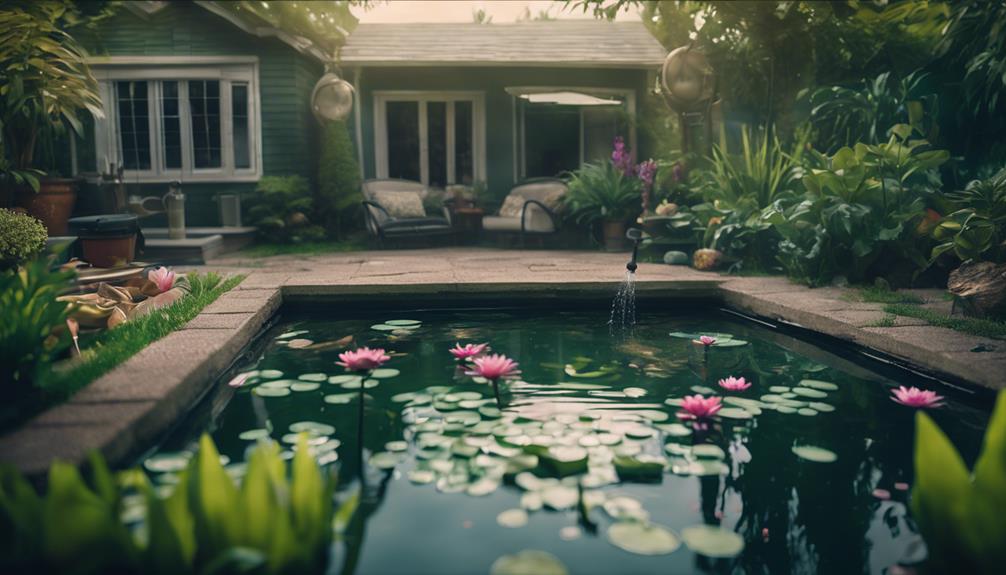
With your sub-surface diffused aeration fundamentals in place, it's time to select the right pump and air line combination to bring your DIY aeration system to life.
Choosing the correct compressor type is vital, as it'll determine the system's performance. You'll need to decide between linear and rocking piston compressors. Linear compressors are a popular choice for DIY setups due to their quiet and economical operation, but they've a depth limitation, typically up to 8 feet. Rocking piston compressors, on the other hand, are more versatile and can handle depths from 6 to 50 feet.
When it comes to air line materials, you'll need to ponder the following:
Polyline is an inexpensive option, but it requires weighting down and can float on the surface.
Thick-walled weighted line is more durable, has a longer lifespan (5-15 years), and warranty, making it a better option for most DIY setups.
Air line length is typically 100 feet or less for DIY packages, so choose the right pump and air line combination for peak performance.
Effective Diffuser Placement and Maintenance
Properly positioning your diffusers is crucial to achieving ideal oxygen distribution and circulation within your DIY fish pond, as incorrect placement can lead to ineffective aeration and stagnant water. You'll want to place your diffusers near the pond's floor, where water circulation is typically weakest. This guarantees that oxygen is distributed evenly throughout the pond.
| Factor | Optimal Configuration |
|---|---|
| Depth | 1-2 feet from pond floor |
| Angle | 45-degree angle to promote water circulation |
| Cleaning | Clean diffusers every 2-3 months to maintain bubble pattern
Frequently Asked Questions
How Can I Aerate My Pond Cheaply?
To aerate your pond cheaply, consider your pond's size and water quality, then opt for an energy-efficient DIY system, like a solar-powered aerator or a sub-surface diffused system, which can improve oxygen levels without breaking the bank.
How to Make an Aerator for a Fish Pond?
"Imagine a tranquil oasis, where water dances with oxygen! To create this haven, you'll modify a pond pump, applying aerator design principles, and craft a DIY diffuser, ensuring a healthy habitat for your finned friends to thrive in."
How to Oxygenate a Pond Quickly?
When you need emergency oxygenation, you can achieve rapid revival and instant refresh by using a fine bubble diffuser, which increases dissolved oxygen levels efficiently, providing a quick fix for your pond's oxygen-deprived waters.
What Do I Need to Aerate My Pond?
To aerate your pond, you'll need to ponder your pond's size and depth, perform regular water quality checks, and choose the right aeration system type, such as solar-powered or electric, to guarantee ideal oxygen levels.
Conclusion
As you wade through the world of DIY fish pond aeration, remember that every bubble counts.
With these 10 hacks, you'll be well on your way to creating a thriving ecosystem that's both cost-effective and environmentally friendly.
So, plunge in and get creative – your fish will thank you.
After all, a healthy pond is just a breath away, and with these DIY aeration hacks, you're about to give your aquatic friends the gift of life-giving oxygen.

